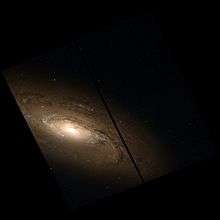NGC 5005
| NGC 5005 | |
|---|---|
 NGC 5005 imaged by the Hubble Space Telescope | |
| Observation data (J2000 epoch) | |
| Constellation | Canes Venatici[1] |
| Right ascension | 13h 10m 56.2s[2] |
| Declination | +37° 03′ 33″[2] |
| Redshift | 946 ± 5 km/s[2] |
| Distance | ~ 65 e6ly (~ 20 Mpc)[2] |
| Apparent magnitude (V) | 10.6[2] |
| Characteristics | |
| Type | SAB(rs)bc[2] |
| Apparent size (V) | 5′.8 × 2′.8[2] |
| Other designations | |
| UGC 8256,[2] PGC 45749,[2] Caldwell 29 | |
NGC 5005 (also known as Caldwell 29) is an inclined spiral galaxy in the constellation Canes Venatici. The galaxy has a relatively bright nucleus and a bright disk that contains multiple dust lanes.[3] The galaxy's high surface brightness makes it an object that is visible to amateur astronomers using large amateur telescopes.
Distance measurements for NGC 5005 vary from 13.7 megaparsecs (45 million light-years) to 34.6 megaparsecs (113 million light-years), averaging about 20 megaparsecs (65 million light-years).[2]
Nucleus
NGC 5005 contains a low ionization nuclear emission region (LINER) nucleus.[4] LINER nuclei contain weakly ionized gas. The power source for the LINER emission has been debated extensively, with some researchers suggesting that LINERs are powered by active galactic nuclei that contain supermassive black holes and other researchers suggesting that LINERs are powered by star formation activity.
X-ray emission
X-ray observations of NGC 5005 have revealed that it contains a variable, point-like hard X-ray source in its nucleus.[5] These results imply that NGC 5005 contains a supermassive black hole. The strong, variable X-ray emission is characteristic of the emission expected from the hot, compressed gas in the environment outside a black hole in an active galactic nucleus.
Companion galaxy
NGC 5005 and the nearby spiral galaxy NGC 5033 comprise a physical galaxy pair.[6] The two galaxies weakly influence each other gravitationally, but they are not yet close enough to each other to be distorted by the tidal forces of the gravitational interaction.
Notes
- ↑ R. W. Sinnott, ed. (1988). The Complete New General Catalogue and Index Catalogue of Nebulae and Star Clusters by J. L. E. Dreyer. Sky Publishing Corporation and Cambridge University Press. ISBN 0-933346-51-4.
- 1 2 3 4 5 6 7 8 9 10 "NASA/IPAC Extragalactic Database". Results for NGC 5005. Retrieved 2006-08-24.
- ↑ A. Sandage; J. Bedke (1994). Carnegie Atlas of Galaxies. Washington, D.C.: Carnegie Institution of Washington. ISBN 0-87279-667-1.
- ↑ L. C. Ho; A. V. Filippenko; W. L. W. Sargent (1997). "A Search for "Dwarf" Seyfert Nuclei. III. Spectroscopic Parameters and Properties of the Host Galaxies". Astrophysical Journal Supplement. 112 (2): 315–390. Bibcode:1997ApJS..112..315H. arXiv:astro-ph/9704107
 . doi:10.1086/313041.
. doi:10.1086/313041. - ↑ Y. Terashima; N. Iyomoto; L. C. Ho; A. F. Ptak (2002). "X-Ray Properties of LINERs and Low-Luminosity Seyfert Galaxies Observed with ASCA. I. Observations and Results". Astrophysical Journal Supplement. 139 (1): 1–36. Bibcode:2002ApJS..139....1T. arXiv:astro-ph/0203005
 . doi:10.1086/324373.
. doi:10.1086/324373. - ↑ G. Helou; E. E. Salpeter; Y. Terzian (1982). "Neutral hydrogen in binary and multiple galaxies". Astronomical Journal. 87: 1443–1464. Bibcode:1982AJ.....87.1443H. doi:10.1086/113235.
External links
![]() Media related to NGC 5005 at Wikimedia Commons
Media related to NGC 5005 at Wikimedia Commons
- NGC 5005 on WikiSky: DSS2, SDSS, GALEX, IRAS, Hydrogen α, X-Ray, Astrophoto, Sky Map, Articles and images